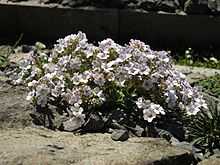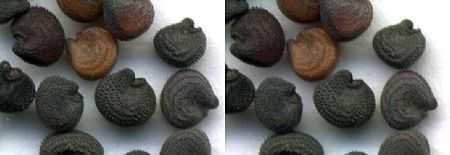Gypsophila
| Gypsophila | |
|---|---|
.jpg) | |
| Gypsophila repens | |
| Scientific classification | |
| Kingdom: | Plantae |
| (unranked): | Angiosperms |
| (unranked): | Eudicots |
| (unranked): | Core eudicots |
| Order: | Caryophyllales |
| Family: | Caryophyllaceae |
| Genus: | Gypsophila L. |
| Species | |
|
about 150 | |
Gypsophila /dʒɪpˈsɒfɪlə/[1][2] is a genus of flowering plants in the carnation family, Caryophyllaceae. They are native to Eurasia, Africa, Australia, and the Pacific Islands.[3] Turkey has a particularly high diversity of Gypsophila taxa, with about 35 endemic species.[4] Some Gypsophila are introduced species in other regions.[3]
The genus name is from the Greek gypsos ("gypsum") and philios ("loving"), a reference to the gypsum-rich substrates on which some species grow.[3] Plants of the genus are known commonly as baby's-breath,[3][5] a name which also refers specifically to the well known ornamental species Gypsophila paniculata.
Description
Gypsophila are annual and perennial herbs often growing from a thick taproot or a branching caudex, sometimes with rhizomes. The stems are usually erect and branching or sprawling, or in a few species prostrate along the ground. The leaves are variable in shape. The inflorescence is usually a cyme or a thyrse, branching intricately. Each small flower has a cup-like calyx of white-edged green sepals containing five petals in shades of white or pink. The fruit is a rounded or oval capsule opening at valves. It contains several brown or black seeds which are often shaped like a kidney or a snail shell.[3]
Uses
A few species are commercially cultivated for several uses, including floristry, herbal medicine, and food. The baby's-breath most commonly used in flower arrangements such as bouquets is the common gypsophila, G. paniculata.[6] G. elegans is also used as a cut flower.[7]
The genus is a source of saponins that can be used for many purposes, including the production of photographic film and hemolytic laboratory reagents. Their detergent qualities make them useful in soap and shampoo.[6]
G. rokejeka is used to make the dessert halva.[6] Species are also ingredients in liqueur, cheese, and ice cream, providing flavor, aroma, and crispness to foods.[8]
Several species are hyperaccumulators of boron, and may be planted to absorb the element from polluted soils.[8]
Ecology
Some species are known as weeds, including the "aggressive ornamental" G. paniculata, which invades habitat and competes with native flora.[9]
Selected species
There are about 150 species in the genus.[3][10]

Stereo image | ||
| ||
| ||
| ||
| ||
| Gypsophila sp. seeds |
Species include:
- Gypsophila acutifolia – sharpleaf baby's-breath
- Gypsophila altissima
- Gypsophila aretioides
- Gypsophila arrostii – Arrost's baby's-breath
- Gypsophila bicolor
- Gypsophila capituliflora
- Gypsophila cephalotes
- Gypsophila cerastioides – chickweed baby's-breath
- Gypsophila davurica
- Gypsophila desertorum
- Gypsophila elegans – showy baby's-breath
- Gypsophila fastigiata – fastigiate gypsophila
- Gypsophila glandulosa
- Gypsophila glomerata
- Gypsophila huashanensis
- Gypsophila libanotica
- Gypsophila licentiana
- Gypsophila muralis – annual gypsophila, cushion baby's-breath, low baby's-breath
- Gypsophila nana – dwarf gypsophila
- Gypsophila oldhamiana – Manchurian baby's-breath, Oldham's baby's-breath
- Gypsophila pacifica
- Gypsophila paniculata – baby's-breath, common gypsophila, panicled baby's-breath
- Gypsophila patrinii
- Gypsophila perfoliata – perfoliate gypsophila
- Gypsophila petraea
- Gypsophila pilosa – Turkish baby's-breath
- Gypsophila repens – alpine gypsophila, creeping baby's-breath
- Gypsophila rokejeka
- Gypsophila ruscifolia
- Gypsophila scorzonerifolia – glandular baby's-breath, garden baby's-breath
- Gypsophila sericea
- Gypsophila silenoides
- Gypsophila spinosa
- Gypsophila stevenii – Steven's baby's-breath
- Gypsophila struthium
- Gypsophila tenuifolia
- Gypsophila tschiliensis
- Gypsophila uralensis
- Gypsophila venusta
- Gypsophila viscosa
References
- ↑ Sunset Western Garden Book, 1995:606–607
- ↑ Gypsophila at USDA PLANTS Database
- ↑ 3.0 3.1 3.2 3.3 3.4 3.5 Gypsophila. Flora of North America.
- ↑ Korkmaz, M., et al. (2012). Habitat properties of some Gypsophila L. (Caryophyllaceae) taxa of Turkey. Biyoloji Bilimleri Araştırma Dergisi (BİBAD) 5(2), 111-25.
- ↑ Gypsophila. Integrated Taxonomic Information System (ITIS).
- ↑ 6.0 6.1 6.2 Henry, M. Gypsophila paniculata L. (baby's breath): in vitro culture and the production of gypsogenin saponins. In: Medicinal and Aromatic Plants IV (pp. 187-206). Springer Berlin Heidelberg. 1993.
- ↑ Gypsophila elegans. Landscape Horticulture. American University of Beirut.
- ↑ 8.0 8.1 Korkmaz, M., et al. Economic importance and using purposes of Gypsophila L. and Ankyropetalum Fenzl (Caryophyllaceae) of Türkiye. In: 2nd International Symposium on Sustainable Development, June 8-9, 2010, Sarajevo.
- ↑ Baby's Breath (Gypsophila paniculata). Plant Health & Pest Management, Ministry of Agriculture, British Columbia.
- ↑ Gypsophila. The Plant List.
External links
-
 Media related to Gypsophila at Wikimedia Commons
Media related to Gypsophila at Wikimedia Commons - GRIN Species Records of Gypsophila. Germplasm Resources Information Network (GRIN).
